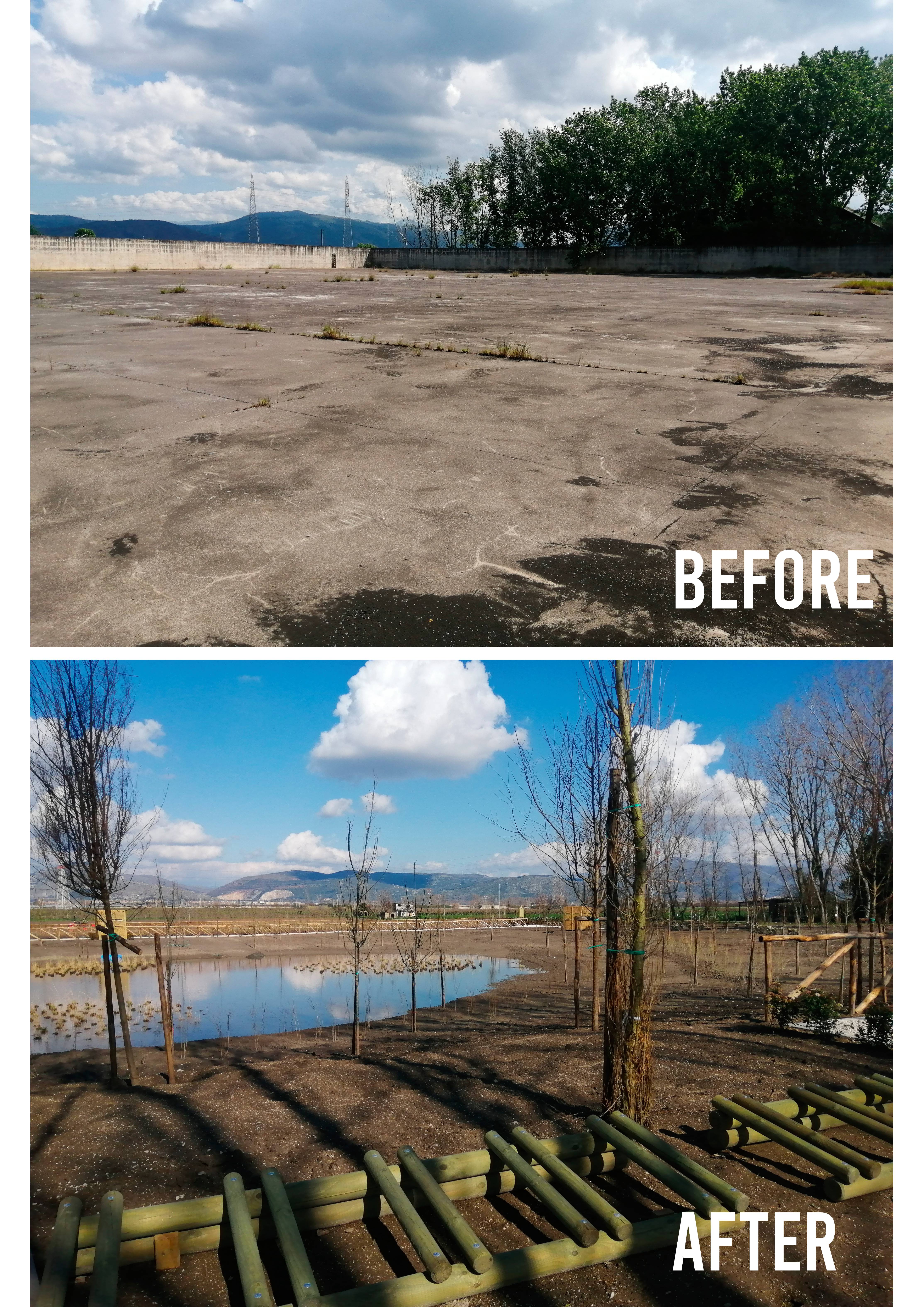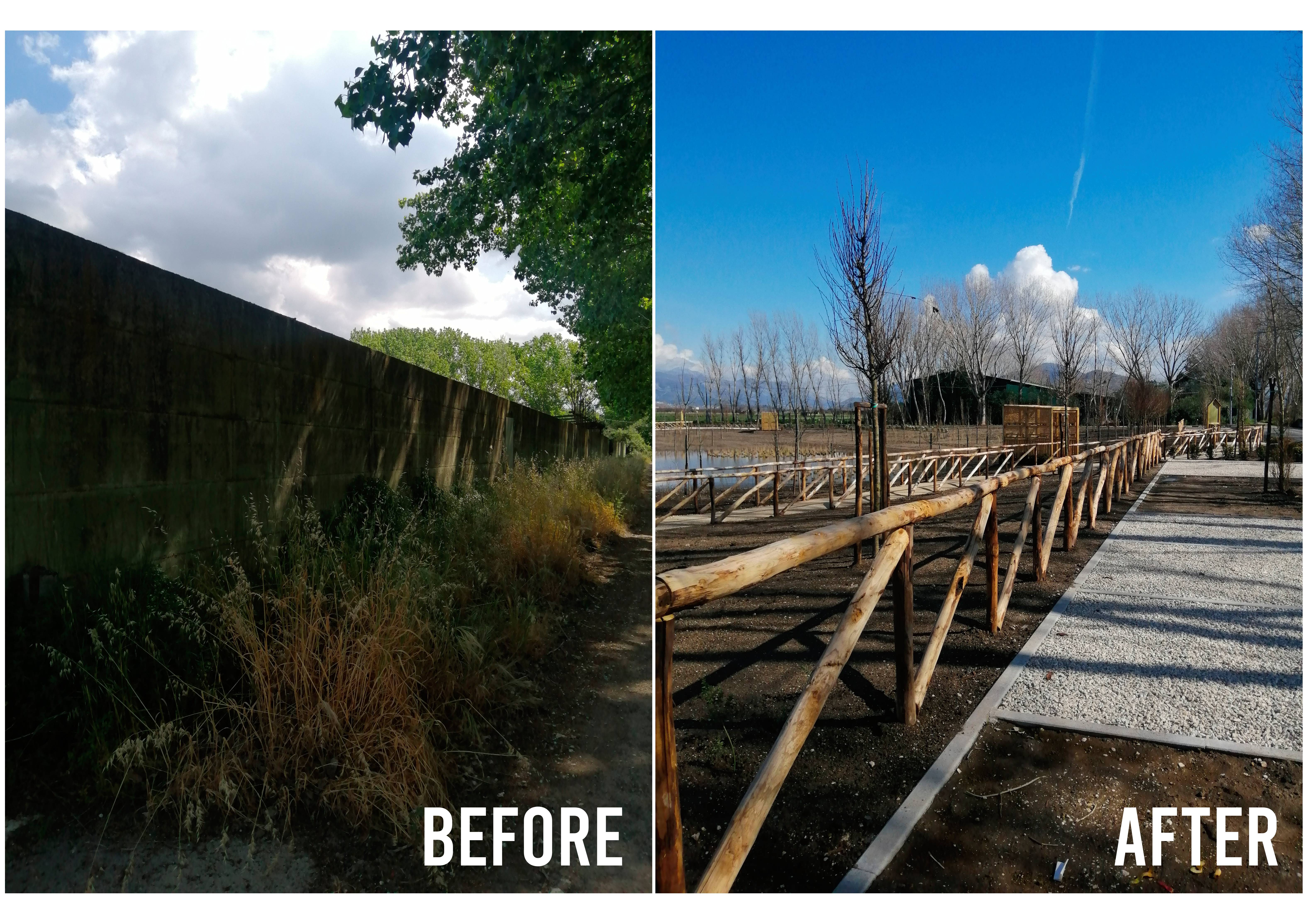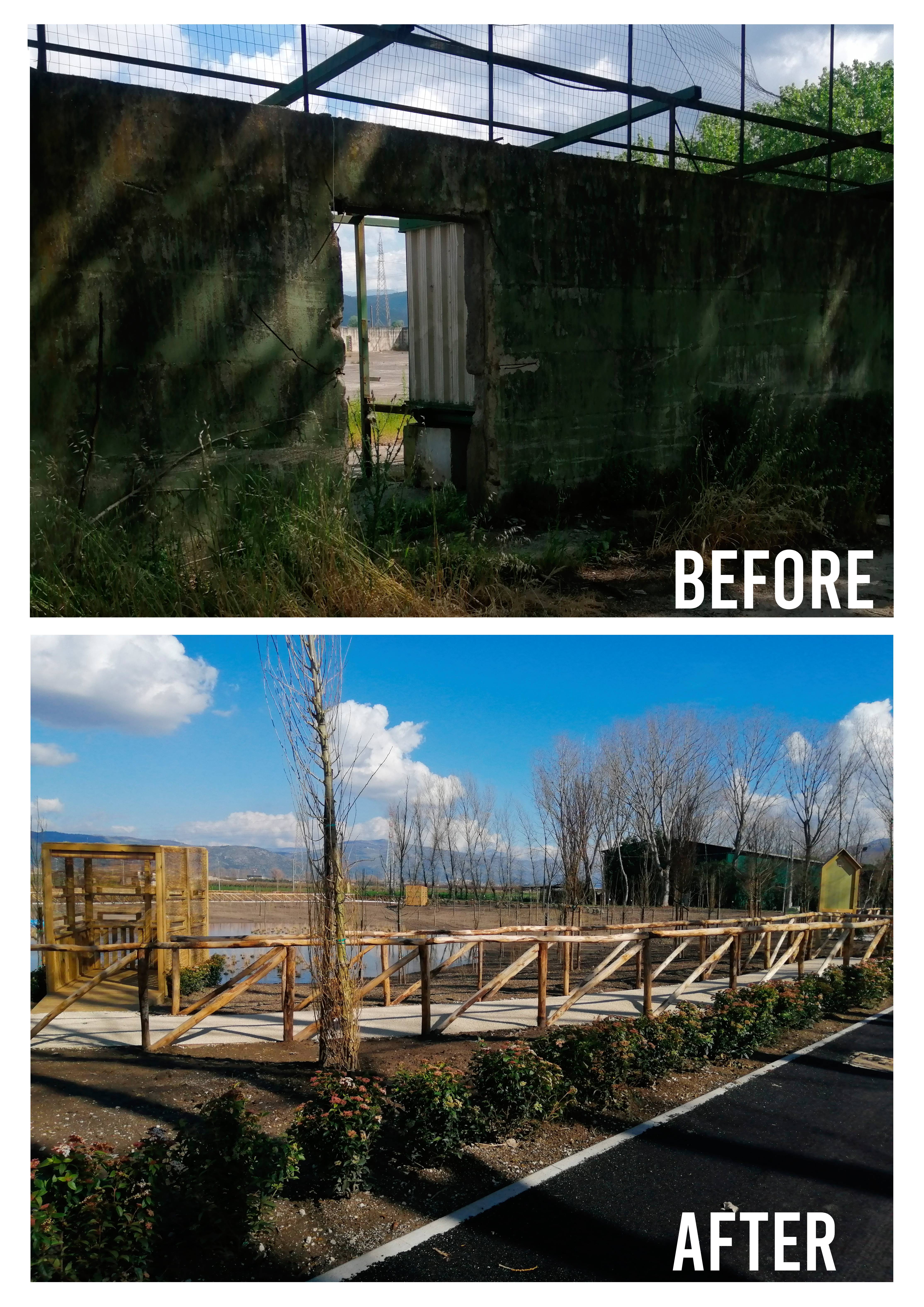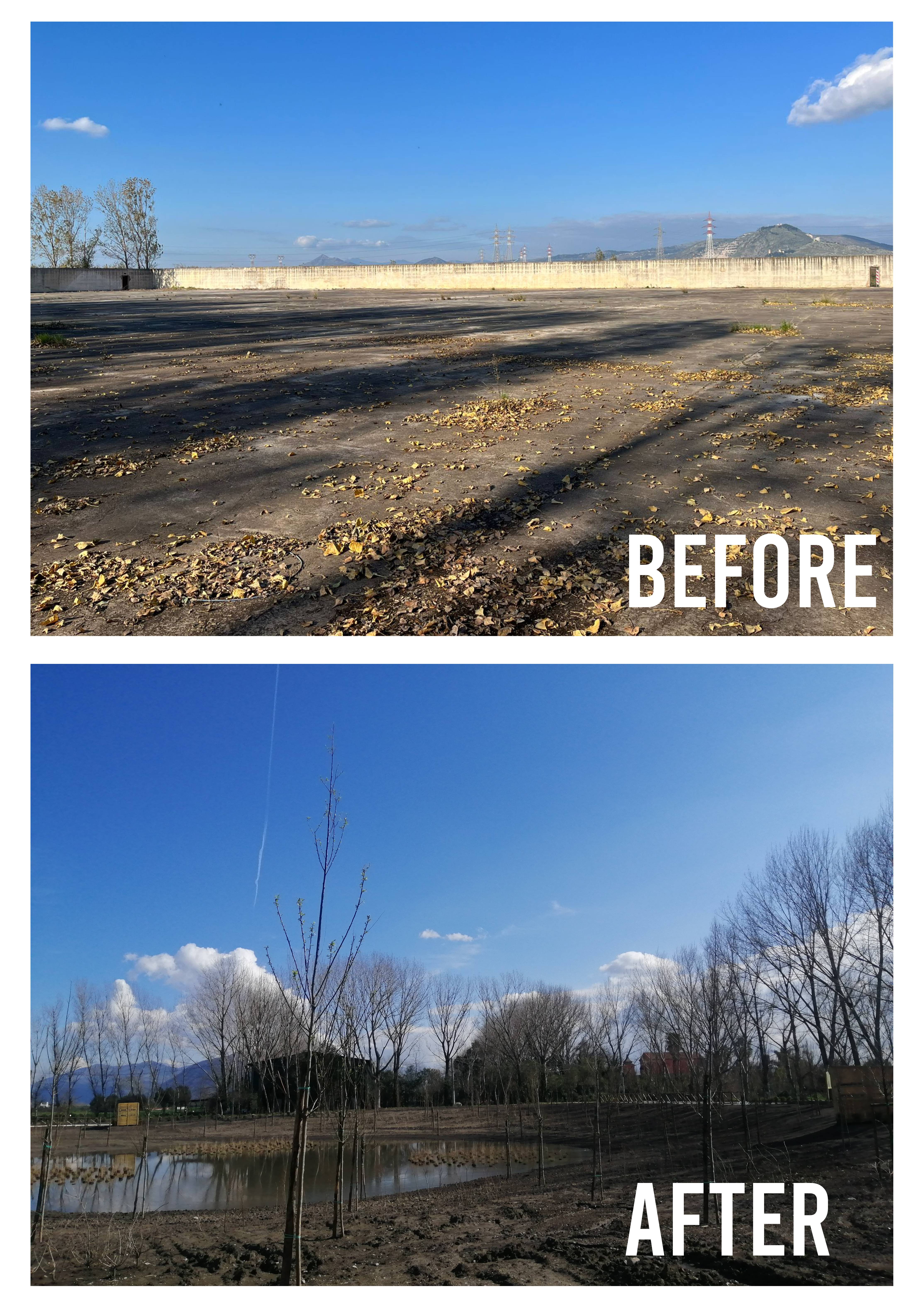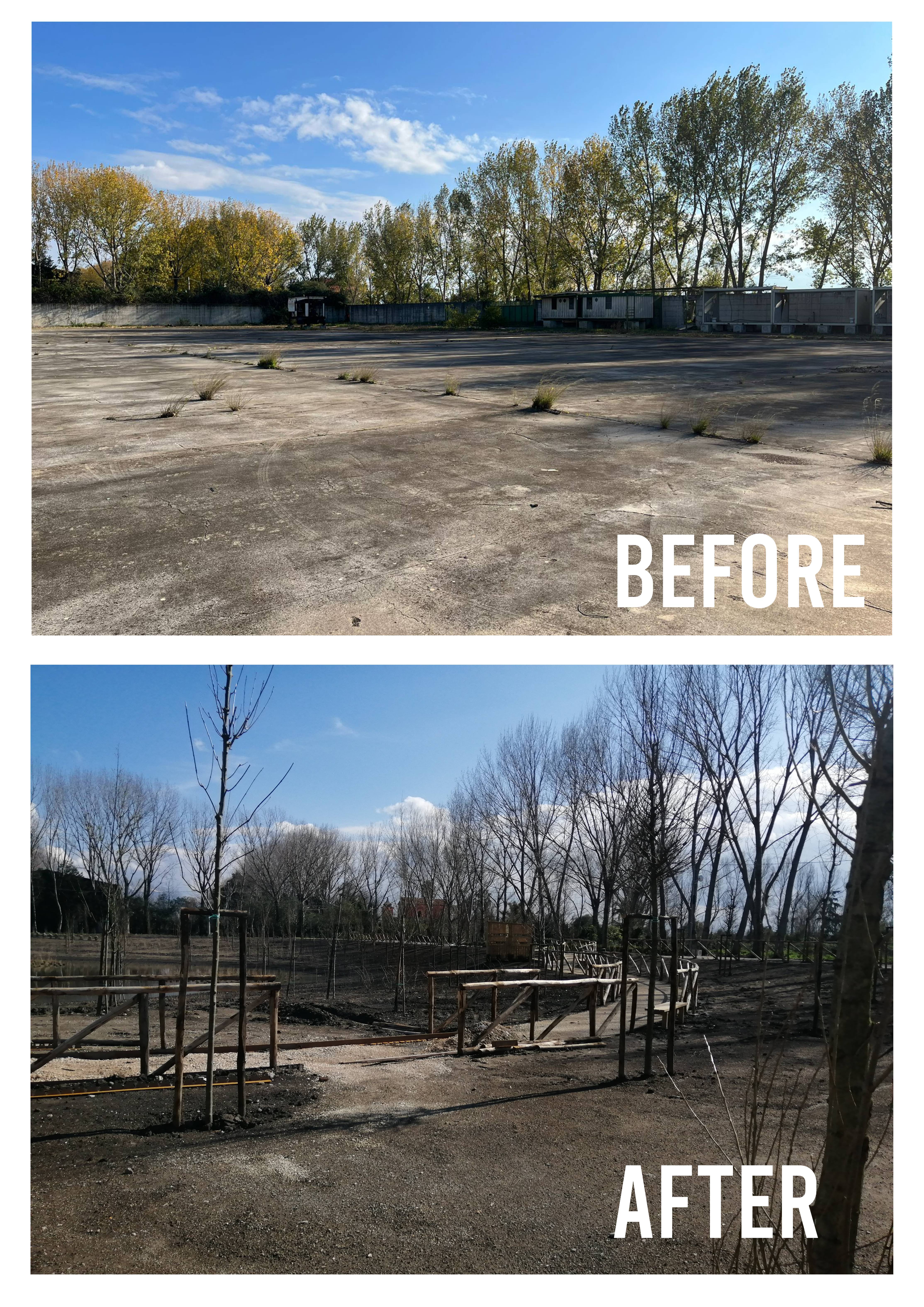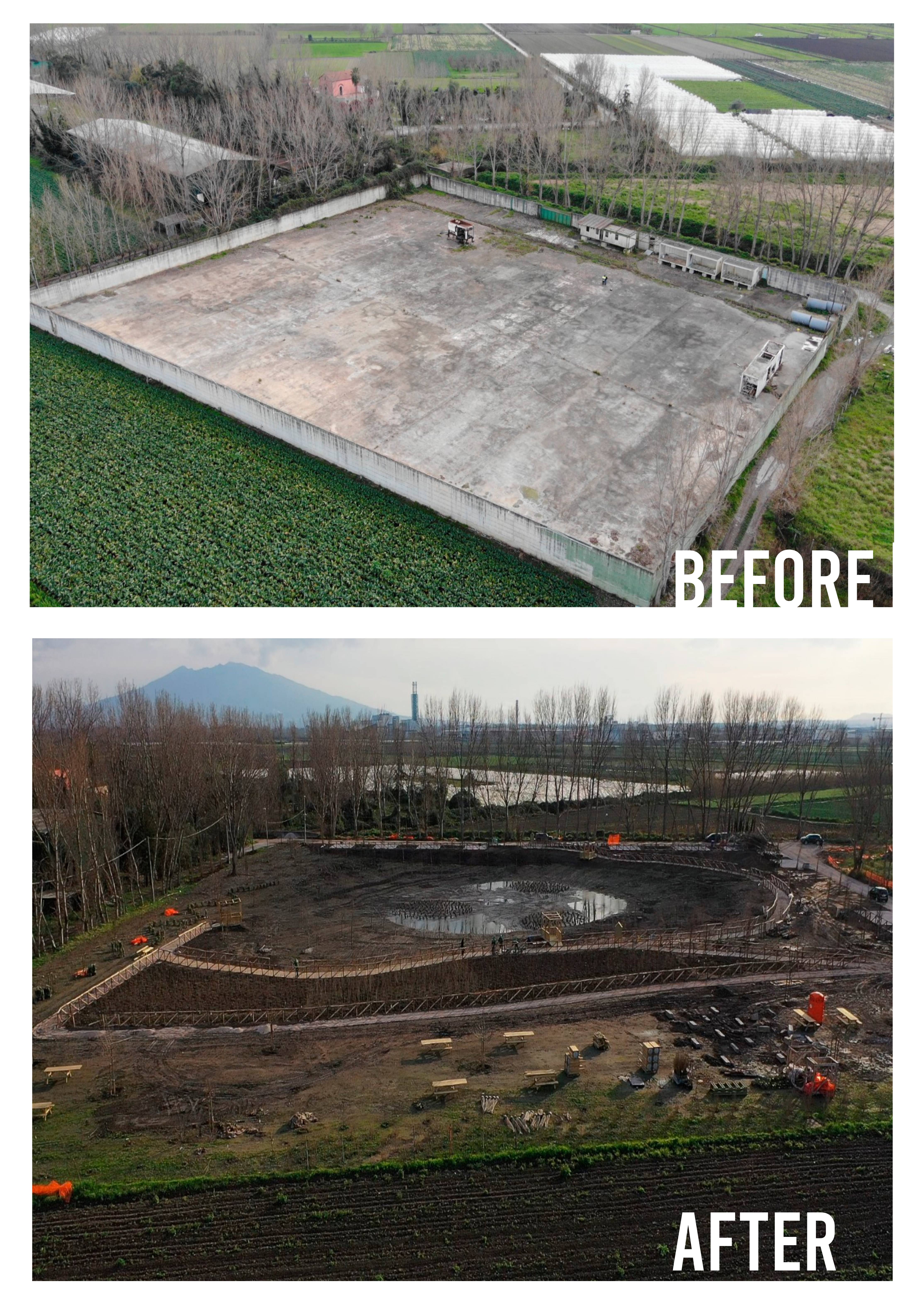Reconnecting with nature
Oasi della forcina
Rinaturalizzazione delle sorgenti del Riullo e del Rio Gorgone e valorizzazione del parco naturale
The Oasi della Forcina is an example of how PNRR funds have been used to address environmental challenges, transforming them into opportunities for renaturalization. The intervention involved the demolition of concrete structures and the restoration of the original natural habitat. This project promotes community well-being and also contributes to environmental protection, restoring an area of great ecological and cultural value to the public.
Italy
Regional
Campania
Mainly rural
It refers to a physical transformation of the built environment (hard investment)
Yes
2025-01-31
Yes
Fondi Next Generation EU - P.N.R.R.
No
No
As a representative of an organisation
The category being applied for is “reconnecting with nature,” as the Oasi della Forcina represents an example of physical transformation that contributes to the regeneration of ecosystems and biodiversity, while also emphasizing the educational aspect by fostering the relationship between humans and nature in terms of belonging and protection. The area that was intervened in lies between the natural and semi-natural landscapes of the Acerra territory, providing ecosystem services that are essential for mitigating climate change and disaster risk. The transformation of an waste bale storage site into a green area has created a network of green infrastructures that increases the connectivity of the ecological network, helps improve habitat conditions, prevents biodiversity decline, and enhances the provision of ecosystem services. An important aspect of this project is the restoration of wetlands, which play a vital role in ensuring the success of bird migration. They provide food and shelter for migrating birds, allowing them to cope with their long journeys. In addition to providing habitat for aquatic birds, wetlands mitigate the devastating effects of flooding, filter pollutants, and are an integral part of the biosphere. The study of socio-ecological interconnections has paid particular attention to nature-based solutions (NBS); in fact, the intervention aims to enhance the area, previously considered peripheral or secondary in urban planning, giving it significant socio-ecological value, particularly in terms of risk mitigation.The intervention is comparable to initiatives such as the “Trans-European Natura Network,” “Rewilding Europe,” and the “BEST” initiative, which aim to increase European biodiversity.
sustainability
ecosystem restoration
accessibility
contact with nature
biodiversity
One of the key sustainability features of the project is soil permeability: the area, which was previously covered with impermeable materials, has been restored by uncovering the naturally permeable ground and creating internal pedestrian pathways made from highly draining materials, thus preventing flooding and promoting a natural water balance. In particular, a lakeside area was designed that not only serves an aesthetic function but also contributes to groundwater preservation and rainwater management. An agroecosystem was created using local and native plant species, selected to ensure the conservation of the region's typical landscape and promote ecological interactions between various plant and animal species. The plants were chosen for their adaptability to climate change and resistance to soil conditions, contributing to the sustainable management of green spaces. The area was designed to provide an ideal environment for the repopulation of local wildlife, with the variety of habitats created allowing different species to thrive. Another essential aspect of the project was its impact on improving air quality and enhancing the well-being of the people. The oasis is a recreational space for connection with nature, improving both the physical and mental health of the community. Additionally, the project incorporated circular economy principles by repurposing materials from the demolition for reuse in other construction sites, thus reducing the overall environmental impact and minimizing waste production, offering a concrete solution to reduce the environmental footprint. In summary, the project has transformed a degraded area into a highly sustainable space, combining environmental restoration, biodiversity promotion, and social well-being, effectively addressing contemporary ecological and climate challenges.
The intervention has transformed an waste bales deposit, restoring the beauty of a natural landscape. The area was designed to integrate seamlessly with the agricultural surroundings, while also standing out as a green oasis, a sanctuary for wildlife, and a recreational space for the public. The decision to create a diverse landscape, featuring local and native plants, contributed to a natural, fluid aesthetic that evolves with the seasons, offering constantly changing and captivating views. The creation of a small lakeside basin, at full capacity, enhances the area's visual appeal, evoking a sense of tranquility and serenity. Another key aesthetic feature is the variety of habitats: from the lakeside area to the shrub and tree vegetation, each zone was carefully designed to evoke different emotions, guiding visitors from expansive, panoramic spaces to more intimate, sheltered ones. The pedestrian paths encourage visitors to explore and discover every corner of the park, allowing them to immerse themselves fully in nature. This green oasis has added significant aesthetic and landscape value that far exceeds the mere reclamation of a degraded area. The project stands as a notable exception to typical territorial transformation processes, making a meaningful contribution to the city's natural heritage. The area has become a symbol of ecological resilience, a place where aesthetics and functionality coexist, and where humans and nature harmonize. The aesthetic impact of this project not only enriches the visual landscape but also functions as an environmental education tool and promotes well-being, providing a public green space where the community can retreat, enjoy nature, and reconnect with the surrounding environment. The choice to name the new green area "Oasi della Forcina" comes from its proximity to the Forcina Bridge, which, crossing the Rio Gorgone and starting from Via Lenza, provides access to the oasis.
The project of transforming a waste dump into a natural oasis not only addresses environmental and social needs but also serves as an example of how revitalization can be a resource for the community, biodiversity, and collective well-being. The combination of ecological innovation, social inclusivity, and cultural awareness makes this project a reference model that can inspire similar initiatives in urban or industrial contexts. Accessibility is one of the key aspects of this project, which has focused on creating green spaces that are easily accessible to all, including people with disabilities or reduced mobility. Accessibility was not viewed as a simple functionality of the oasis but as a true investment in collective well-being. Key features of the intervention included: ergonomic and inclusive furniture (tables with seats easily usable by everyone); barrier-free paths (paved and clearly marked to allow safe passage for strollers and wheelchairs); shaded and resting areas (spaces designed to offer comfort to people of all ages). From an ecological perspective, the intervention not only reduces environmental impact but also promotes a sustainable development model that can be replicated in other contexts. In summary, the project represents an example of how the integration of advanced ecological solutions and universal accessibility can converge into an initiative that not only improves the environment but also promotes social cohesion, inclusion, and a culture of sustainability. By creating a replicable model, this project provides a concrete response to the challenges of urban regeneration and sustainability, becoming a reference point for future initiatives aimed at recovering and enhancing industrial and degraded areas.
The involvement of the beneficiary citizens and civil society was a key element that ensured the transparency of the process, making it both inclusive and responsive to the real needs of the local community. Citizens were continuously informed of the procedural stages through regular publications on the municipality's website. Information served as an important tool for participation in the ideals and goals of the regeneration the project represents. Everyone was able to follow the evolution of the initiative, understand its objectives, and clearly see the long-term benefits for the community and the environment. Furthermore, the involvement of citizens had a significant impact, strengthening social cohesion. Active participation reinforced the sense of belonging and responsibility of the community toward the project. Citizens viewed the oasis not only as a public asset but as a space they co-create, fostering a deeper commitment to its care and maintenance. This had a positive effect on the culture of sustainability, encouraging more responsible environmental behaviors among the community. Additionally, a web page was created within the “Antica Città di Suessola” Urban Park’s website with the goal of establishing a digital tourism hub. Accessible through a dedicated online platform, this hub connects the entire tourism ecosystem to enhance, integrate, and promote user participation in the cultural and hospitality offerings of the municipality of Acerra.
At the European level, the National Recovery and Resilience Plan (PNRR) is part of the European Union's recovery program – the European Recovery Fund. The National Plan for Recovery and Resilience is divided into 7 Missions, which represent the main thematic areas of intervention, identified in full alignment with the 6 pillars of Next Generation EU. The Ministry of the Interior is responsible for 4 investments, including those in urban regeneration projects. The point of contact with the Central Service for the PNRR is the Mission Unit at the general managerial level for the implementation of the National Recovery and Resilience Plan interventions.National authorities played a role in ensuring that the project met national standards for environmental management, accessibility, and urban development. They provided funding through specific programs for environmental regeneration and urban renewal. Local government played a central role in coordinating and facilitating the project. Their involvement ranged from approving permits and financing the initial stages to overseeing implementation and ensuring that local needs were addressed. Municipal authorities were also responsible for public information and promoting participation. Through regular communication, including publications on the municipal website, public meetings, and open consultations, they ensured that the project was transparent and aligned with the community's desires. The direct involvement of local government ensured that the project was tailored to the needs and priorities of the community, facilitating smoother implementation and greater public support. Furthermore, their role in securing resources and managing public services (such as waste management, public safety, etc.) ensured that the project remained feasible and functional.
The project involved a wide range of disciplines and areas of expertise, which contributed both to the design and implementation of the intervention, making it possible to adopt an integrated and sustainable approach, with the broader ambition of creating an 'exemplary' process for other innovative interventions at various scales. First and foremost, ecological and agronomic knowledge was essential to understanding the characteristics of the land, ecological dynamics, and the restoration of local biodiversity. Ecological experts analyzed the quality of existing habitats, identifying issues related to biodiversity loss and designing targeted solutions to improve connectivity between ecosystems, such as the creation of ecological corridors and the restoration of wetlands. This work was crucial for the conservation of local species and the promotion of sustainable ecological balance. Agronomy experts supported the intervention by selecting native plant species, facilitating the restoration of natural vegetation, and ensuring the creation of suitable habitats for local wildlife. This approach contributed to more responsible land management, reducing the impact of invasive species and fostering the growth of a more resilient and self-sustaining ecosystem. At the same time, landscape architecture specialists used their expertise to design green spaces that were not only ecologically functional but also accessible and attractive to the community. Their challenge was to integrate ecological infrastructures, such as stormwater management and air quality improvement, with the surrounding environment, without overlooking the importance of aesthetic and social needs. The Oasi della Forcina was designed to be an area that not only promotes ecological well-being but also serves as a community gathering point, a safe, welcoming, and educational space.
The innovative character of the project lies in its comprehensive and effective approach to urban regeneration, which distinguishes it from traditional or more common actions in this field. 1. It undoubtedly represents the full implementation of the European objectives of the National Recovery and Resilience Plan (PNRR), aligning with the pillars of Next Generation EU, which focus on sustainability, social inclusion, and resilience. Unlike conventional urban projects that may prioritize other aspects, this project incorporates environmental regeneration as a central component, prioritizing both sustainability and aesthetics. 2. The transformation of a previously cemented area into a green oasis represents an ecological regeneration intervention that not only improves aesthetics but also restores biodiversity. The introduction of native vegetation, the creation of green spaces, and the planting of trees contribute to restoring local ecosystems and promoting wildlife. 3. The integration of public green spaces into a previously built-up area marks a rethinking of the concept of urban space. It is not just about adding vegetation but about rethinking the entire use of space, creating environments for socialization, well-being, and interaction among citizens, in contrast to traditional cemented and sterile areas. 4. A project like this helps make the city more resilient to climate change. Green areas act as "lungs" that improve air quality, reduce pollution, and allow for the natural management of rainwater, reducing the risk of flooding. This type of approach to urban planning is crucial in the context of increasingly evident climate change. It represents a step toward the creation of more ecological and livable smart cities, where advanced technologies and sustainability go hand in hand with improvement.
The urban regeneration process carried out was complex and multifactorial, with the aim of improving existing urban areas through physical, economic, and social transformation. It was an integrated approach to city transformation, involving local authorities, the community, technicians, and businesses. The project's approach was based on the study of urban transformations, relating the processes of deindustrialization and deurbanization to the processes of reuse that alter the city's appearance. The renaturalization of the area was carried out with the aim of completing urban fringes, understood as the reappropriation of peri-urban areas and degraded fringe zones, with in-between areas that lacked quality and had poor integration with the open territory. The intervention, while not involving the new occupation of land, is considered a virtuous example because it was designed in compliance with sustainability criteria. The renaturalization of the "anthropized" space aimed at improving sustainability, focusing on degraded ecosystems, biodiversity, responses to climate change, and risk mitigation, with a preference for natural-based solutions. A Nature-Based Solutions (NBS) approach, where design solutions are responses to societal challenges inspired and supported by nature, was adopted. In contrast to technology-centered solutions, this approach uses natural elements as tools for urban design to create more sustainable solutions. It was primarily an intervention that embraced concepts such as ecosystems, ecosystem services, and green infrastructures. Ecologically, the introduction of these solutions led to improvements in the performance and environmental efficiency of the territorial system, while also protecting existing ecosystems or introducing new ones, thus increasing the natural character of the area where the intervention took place.
The main element of the project is the transformation of a natural area, altered by human activity, into a livable and attractive park. The area in question was previously a waste dump of eco-bales within the area covered by ECHR judgment 028 (2025), concerning the disposal, burial, or incineration of waste on private land, often carried out by organized criminal groups, in the regions of Campania known as the Terra dei Fuochi. In this area, increased rates of cancer and groundwater pollution had been recorded. Key aspects that characterize the project include reforestation (4387 tree planting) and the conservation of biological and landscape diversity. Vegetation is used for various purposes: to reduce soil pollution, to preserve habitats suitable for various animal species, thus contributing to their conservation and protection both locally and on a broader scale. The enhancement of the ecological network is developed through the introduction of individual trees, patches of vegetation, and the addition of a wetland area. The creation of this natural garden enables the activation of new dynamics of use for the site's visitors, thanks to the creation of welcoming, interesting spaces full of potential, allowing people to spend time in safety and tranquility immersed in a natural environment. The renaturalization intervention has significant meaning in ecology and environmental management due to its role in soil conservation, biodiversity preservation, and its influence on aquatic ecosystems. The reforestation with native vegetation aims to create a vegetated and equipped space, easily accessible to visitors of the "Antica Città di Suessola" Urban Park.
The Oasi della Forcina has given rise to a network of green infrastructures that enhance ecological connectivity, improve habitat conditions, combat biodiversity loss, and strengthen the provision of ecosystem services. This intervention has made possible the revival of a previously exploited and degraded area, demonstrating how, with the right approach, natural and cultural values can emerge and transform into a natural environment of great importance for the local community. The main goal of the project was to combat climate change, with a particular focus on the sustainable management of urban water resources. The creation of the Oasi della Forcina significantly reduced the impermeable surface of the site, contributing to effective rainwater management. This approach has brought tangible benefits both in terms of water availability and quality, improving the microclimate and strengthening local water resources. Another central goal was the restoration of natural habitats, which, through the creation of ecological corridors, improved connectivity between different ecosystems and created vital spaces for numerous local species, promoting their conservation and growth. This intervention fits perfectly into the nature-based solutions (NBS) framework. A fundamental aspect of the project is its educational and awareness-raising dimension: Oasi della Forcina is not only a green space but also a powerful tool to connect the community with nature. The project encourages environmental awareness, promoting values of sustainability, respect for the environment, and understanding of biodiversity. In summary, the project offers concrete local solutions to urgent global challenges, such as climate change, biodiversity loss, and urban sustainability. By creating a park that improves the urban environment, promotes biodiversity, and fosters social inclusion, the project contributes to positive change at the local level, with direct impacts on the quality of life of the community
The urban regeneration project that transformed a waste dump area for ecobales into a green oasis has restored the natural state of the site, improving the quality of the air, soil, and surrounding water. Creating areas with vegetation and adopting an environmental planning approach attentive to the ecological aspects of renaturalization, has produced significant mitigation effects, primarily in terms of avoided greenhouse gas emissions due to reduced energy consumption by buildings, the absence of soil impermeabilization, and changes in land use. These changes mainly relate to the fact that, prior to the creation of the oasis, the area was designated for the storage of ecobales. Among the mitigation effects are also long-term carbon storage in vegetation and soil, improved regulation of flood waves, reduction of the urban heat island effect and heat stress, as well as improved air quality. The ecological value that the area offers in this regard brings benefits to the entire urban system in terms of climate change mitigation. The renaturalization of the area leads to increased biodiversity, in terms of flora, with planted areas and wetlands serving as habitats for numerous species, and consequently, a growth in fauna. The evidence of this process also impacts citizens, fostering a true ecological consciousness within the community: nature reintroduced into the city, not as agricultural land but as a living green space, develops a new social approach where nature is not seen as a resource to exploit, nor as an isolated entity to protect, but as an integral part of the ongoing territorial dynamics.

